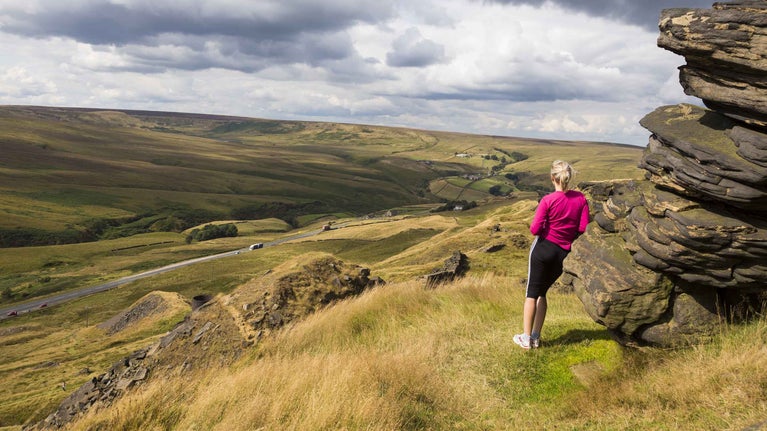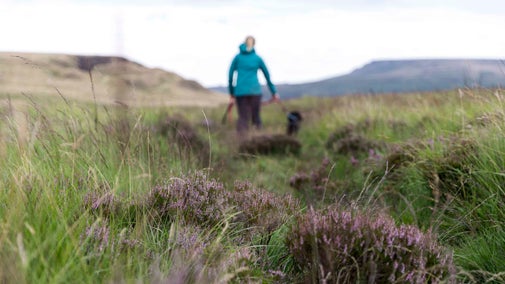
Discover more at Marsden Moor
Find out how to get to Marsden Moor, where to park, the things to see and do and more.

Discover the many plants and animals that call this landscape home. From birds such as golden plovers and curlews to mammals including the mountain hare, there’s an abundance of wildlife on Marsden Moor. It’s also been named as a Site of Special Scientific Interest (SSSI) for its ground-nesting birds. Bring binoculars for birdwatching or simply keep your eyes peeled to see which of the moor’s inhabitants you can spot.
The deep peat covering most of the moor is the ideal habitat for species that can cope with heavy rainfall, little shelter and acidic soil.
Marsden Moor is a Site of Special Scientific Interest (SSSI) on account of the breeding bird population. It’s particularly important due to the decline of some upland bird species in Europe. Several birds arrive on Marsden Moor in late February to breed and raise their young.
In this treeless landscape, the birds nest on the ground, leaving them vulnerable to predators and disturbance from people and dogs. For this reason, you must stay on the footpaths and keep dogs on a short lead during nesting season (1 March to 31 July).
Also known as the Pennine finch, the Twite is one of the UK’s most threatened birds. It feeds entirely on seeds, but seed-rich grassland habitats have been in decline. The Peak District and South Pennines area is one of the strongholds of this little brown bird.
The golden plover is an impressive wading bird with a gold speckled back. It breeds on upland heathland and blanket bog. A major food source is the cranefly, which favours the wetter areas of the moorlands.
The merlin is Britain’s smallest bird of prey. It's a compact falcon that spends the summer in the uplands nesting in patches of long heather. Their main prey is the meadow pipit.
Short-eared owls are largely nocturnal but they also hunt for voles during daylight. This is why they’re one of the more commonly seen owls in Britain.

Curlews are large waders with a distinctive call and long, down-curved bill. They spend winter in coastal areas and arrive on the moorland in spring to breed.
The snipe is a medium-sized wader with a long straight bill. Listen for the males making a ‘drumming’ sound during the mating season. Their tail feathers vibrate in the wind during rapid descents in flight displays.
A small, elusive wader, the dunlin nests on blanket bog. The pools provide an abundance of tiny insects and invertebrates for dunlin chicks.
Though they’re not always easy to see, there are mammals on Marsden Moor too. Scan the landscape for mountain hares, shrews, foxes, voles, weasels and stoats.
Mountain hares are larger than rabbits but smaller than brown hares. They prefer areas of mixed heather and cotton-grass moorland. Their coat changes colour from brown to white in the winter months. This makes them easier to spot in milder winters, or after the snow has melted, when you may see them zigzagging across the moors.

Many species of reptiles and invertebrates live on the moor. They’re an essential part of the upland birds’ diet.
Keep your eyes peeled for the emperor moth in April and May. It's large and has eye spots on all four wings, which look like a cat’s face from a distance.
This small, metallic-green butterfly emerges in late April and stays on the wing until early July. As larvae, they eat a variety of foods including bilberry and cross-leaved heath.
Look out for the UK's most widespread reptile in spring and summer, when they bask in the open to absorb heat from the sun. The common lizard lays eggs in warm climates but bears live young in cold ones.

Find out how to get to Marsden Moor, where to park, the things to see and do and more.
Marsden Moor is a one pawprint rated place. Find out where you can walk your dog and the guidance to follow at different times of the year when walking near livestock and nesting birds.

Explore the many walking trails on Marsden Moor, try Nordic walking for fitness, or join a guided walk to learn about the landscape with a National Trust volunteer.

Learn how National Trust rangers and volunteers are working to care for Marsden Moor by restoring peat, removing invasive species and minimising the risk of floods and fires.
